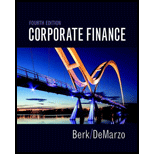
Corporate Finance (4th Edition) (Pearson Series in Finance) - Standalone book
4th Edition
ISBN: 9780134083278
Author: Jonathan Berk, Peter DeMarzo
Publisher: PEARSON
expand_more
expand_more
format_list_bulleted
Question
Chapter 29.5, Problem 2CC
Summary Introduction
To discuss: The new requirements of corporate governance that is added to the Dodd–Frank Act.
Introduction:
Dodd–Frank Act is an act that was enacted in the year 2010 by Country U. This Act came into force due to the 2008 financial crisis. Its main aim is to strengthen financial stability of the Country U governance.
Expert Solution & Answer
Want to see the full answer?
Check out a sample textbook solution
Students have asked these similar questions
Need answer.
Solve plz now
Precious metal qn solve .
Chapter 29 Solutions
Corporate Finance (4th Edition) (Pearson Series in Finance) - Standalone book
Ch. 29.1 - Prob. 1CCCh. 29.1 - Prob. 2CCCh. 29.2 - Prob. 1CCCh. 29.2 - Prob. 2CCCh. 29.3 - What is the main reason for tying managers...Ch. 29.3 - Prob. 2CCCh. 29.4 - Prob. 1CCCh. 29.4 - Prob. 2CCCh. 29.5 - Prob. 1CCCh. 29.5 - Prob. 2CC
Ch. 29.5 - Prob. 3CCCh. 29.6 - Prob. 1CCCh. 29.6 - Prob. 2CCCh. 29 - Prob. 1PCh. 29 - Prob. 2PCh. 29 - Prob. 3PCh. 29 - Prob. 4PCh. 29 - Prob. 5PCh. 29 - Prob. 6PCh. 29 - Prob. 7PCh. 29 - Prob. 8PCh. 29 - Prob. 9PCh. 29 - Prob. 10PCh. 29 - Prob. 11PCh. 29 - Prob. 12PCh. 29 - Prob. 13PCh. 29 - Prob. 14PCh. 29 - Prob. 15PCh. 29 - Prob. 16PCh. 29 - Prob. 17PCh. 29 - Prob. 18PCh. 29 - Prob. 19PCh. 29 - Prob. 20P
Knowledge Booster
Similar questions
arrow_back_ios
SEE MORE QUESTIONS
arrow_forward_ios
Recommended textbooks for you
- Business/Professional Ethics Directors/Executives...AccountingISBN:9781337485913Author:BROOKSPublisher:Cengage
 Auditing: A Risk Based-Approach (MindTap Course L...AccountingISBN:9781337619455Author:Karla M Johnstone, Audrey A. Gramling, Larry E. RittenbergPublisher:Cengage Learning
Auditing: A Risk Based-Approach (MindTap Course L...AccountingISBN:9781337619455Author:Karla M Johnstone, Audrey A. Gramling, Larry E. RittenbergPublisher:Cengage Learning Intermediate Financial Management (MindTap Course...FinanceISBN:9781337395083Author:Eugene F. Brigham, Phillip R. DavesPublisher:Cengage Learning
Intermediate Financial Management (MindTap Course...FinanceISBN:9781337395083Author:Eugene F. Brigham, Phillip R. DavesPublisher:Cengage Learning - Business Its Legal Ethical & Global EnvironmentAccountingISBN:9781305224414Author:JENNINGSPublisher:CengagePrinciples of Accounting Volume 1AccountingISBN:9781947172685Author:OpenStaxPublisher:OpenStax CollegePrinciples of Accounting Volume 2AccountingISBN:9781947172609Author:OpenStaxPublisher:OpenStax College

Business/Professional Ethics Directors/Executives...
Accounting
ISBN:9781337485913
Author:BROOKS
Publisher:Cengage

Auditing: A Risk Based-Approach (MindTap Course L...
Accounting
ISBN:9781337619455
Author:Karla M Johnstone, Audrey A. Gramling, Larry E. Rittenberg
Publisher:Cengage Learning

Intermediate Financial Management (MindTap Course...
Finance
ISBN:9781337395083
Author:Eugene F. Brigham, Phillip R. Daves
Publisher:Cengage Learning

Business Its Legal Ethical & Global Environment
Accounting
ISBN:9781305224414
Author:JENNINGS
Publisher:Cengage

Principles of Accounting Volume 1
Accounting
ISBN:9781947172685
Author:OpenStax
Publisher:OpenStax College

Principles of Accounting Volume 2
Accounting
ISBN:9781947172609
Author:OpenStax
Publisher:OpenStax College